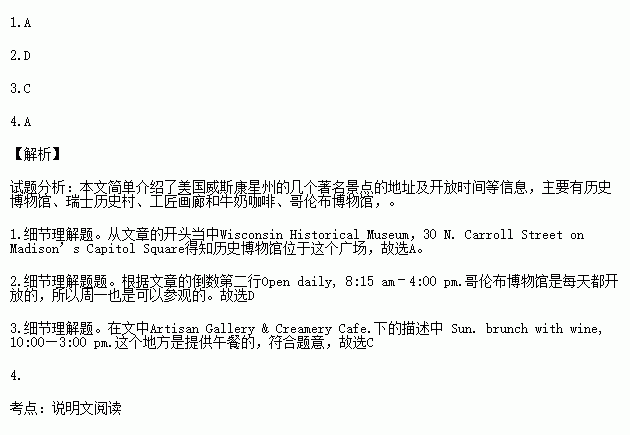题目内容
Wisconsin Historical Museum
30 N. Carroll Street on Madison’s Capitol Square
Discover Wisconsin’s history and culture(文化) on four floors of exhibits. Open for public program. Admission is free.
Open Tuesday through Saturday, 9:00am -- 4:00 pm.
(608) 264-6555 www.wisconsinhistory.org/museum
Swiss historical village
612 Seventh Ave., New Glarus
The Swiss Historical Village offers a delightful look at pioneer life in America’s heartland. 14 buildings in the village give a full picture of every day life in the nineteenth-century Midwest.
Tue.—Fri., May 1st –October 31st , 10:00 am—4:00 pm. Admission is $20.
(608) 527-2317 www.swisshistoricalvillage.com
Artisan Gallery & Creamery Café
6858 Paoli Rd., Paoli, WI
One of the largest collections of fine arts and crafts(手工艺品) in Wisconsin. Over 5000 sp. ft. of exhibition space in a historic creamery. While visiting enjoy a wonderfully prepared lunch at our café overlooking the Sugar River. Just minutes from Madison!
Gallery open Tue. –Sun., 10:00 am—5:00 pm.
Café open Wed. –Sat., 11:00 am –3:00 pm.
Sun. brunch with wine, 10:00—3:00 pm.
(608) 845-6600 www.artisangal.com
Christopher Columbus Museum
239 Whitney St., Columbus
World-class exhibit –2000 quality souvenirs(纪念品) marking Chicago’s 1893 World Columbian Exhibition. Tour buses are always welcome.
Open daily, 8:15 am – 4:00 pm.
(920) 623-1992 www.columbusantiquemall.com
1.Which of the following is on Capitol Square?
A. Wisconsin Historical Museum.
B. Swiss Historical Village.
C. Artisan Gallery & Creamery Café.
D. Christopher Columbus Museum.
2.Where can you go for a visit on Monday?
A. Wisconsin Historical Museum.
B. Swiss Historical Village.
C. Artisan Gallery & Creamery café.
D. Christopher Columbus Museum.
3.Where can visitors have lunch?
A. At Wisconsin Historical Museum.
B. At Swiss Historical Village.
C. At Artisan Gallery & Creamery Café.
D. At Christopher Columbus Museum.
4.We learn from the text that___________.
A. Swiss Historical Village is open for half a year
B. Christopher Columbus Museum overlooks a river
C. tickets are needed for Wisconsin Historical Museum
D. Artisan Gallery & Creamery Café are open daily for 4 hour
 阅读快车系列答案
阅读快车系列答案For: Doug Smith, Director of wolf recovery, Yellowstone National Park In the world today there is so much we are losing; more and more species disappear from the earth every year. The time has come to put something back,to restore to treat some of the old wounds enforced on nature over the years. Wolves are animals killing and eating other animals in North America. They play an important role in keeping the continent healthy. Most places don’t have enough wild country to make their restoration possible, which means it’s even more important to restore wolves where conditions are right, places like Yellowstone, which has both a high level of wildness, as well as abundant creatures that wolves hunt and eat for living. Some who oppose wolf restoration have a human centered point of view that the earth is here for humans, we can use it whenever we want and for whatever purpose. But wolves offer us a chance to live another way—a way to learn to live with other life forms. | Against: Larry Bouret, Vice President, Wyoming Farm Bureau What does wolf introduction to Yellowstone mean? To the average citizen it probably just means introducing wolves to Yellowstone. There would be no unfavorable effects because few people live near Yellowstone. But to farmers it means introducing wolves, which wander over vast areas—in and out of the park—onto their farms. Wolves eat meat—as in the cattle, sheep that keep farmers in business. Introduction apparently also means lawsuits by environmental groups attempting to remove livestock from federal lands. To farmers, who own private lands in the same area, it means the possibility of financial ruin. To farmers it is a form of land use restrictions. To farmers introducing wolves means taking away the farmers’ livelihoods without just compensation. Why do people not want a nuclear power plant built in their backyard? For the same reason farmers do not want wolves introduced into their backyard. |
1.What are the two passages mainly about?
A. Whether to remove livestock away from federal lands.
B. Whether to introduce wolves to Yellowstone.
C. How to increase the number of wolves.
D. How to keep the balance of nature.
2.According to the passage Doug Smith is _______.
A. a national park administrator.
B. a wildlife conservationist.
C. an enthusiastic hunter.
D. a private land owner.
3.What are the farmers concerned about?
A. Being controlled by wolves.
B. Having to sell their farmland.
C. Suffering heavy financial loss.
D. Being forced to leave their homes.
4.Why does Larry Bouret mention “nuclear power plant”?
A. To summarize his opinion.
B. To make his view persuasive.
C. To tell the danger of nuclear power plant.
D. To introduce the background of wolf recovery.

